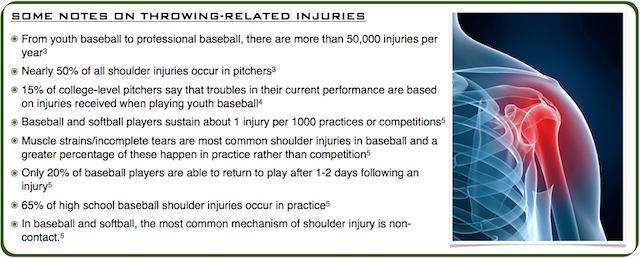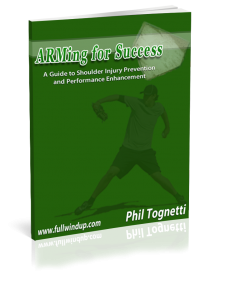The following article is an excerpt from the eBook ARMing for Success. To learn more about the eBook visit this page or you can buy it now here.

The rotator cuff and other scapula stabilizers play a pivotal role in the throwing process. The shoulder’s surrounding tissues are looking to stabilize the shoulder as best as possible when the environment and conditions (i.e. throwing a baseball) call for extreme forces in order to perform the task. These high forces generate velocity and ball speed, but they can also cause injury. It’s a delicate balance.
During a throw, the shoulder moves through four phases:
- Cocking Phase (external rotation)
- Acceleration Phase (internal rotation)
- Deceleration Phase
- Follow Through
Internal rotation of the humerus during throwing can reach velocities of 6,100-9,000º/sec and is followed by eccentric deceleration of the posterior rotator cuff.1 Because shoulder forces, torques, and muscle activity are greatest during the arm cocking and deceleration phase, it is believed that most shoulder injuries occur during these phases.
The four muscles of the rotator cuff help keep the shoulder stable during these high forces. In fact, the rotator cuff activity has to be so high that it can resist the high shoulder distractive forces that can be between 80-120% of the thrower’s bodyweight during the arm cocking and deceleration phases.2
At such high forces, repetitive small microtraumas can occur in the shoulder muscles, capsule, and ligaments resulting in impingement. In addition, a baseball player’s shoulder can become fatigued or strained by throwing too much, throwing incorrectly, or not getting enough rest. Fatigue, strain, or impingement can result in the rotator cuff being unable to perform its job making the entire shoulder more prone to injury.
An overworked rotator cuff is a weak and possibly painful rotator cuff, and therefore is less effective in stabilizing the shoulder. While a ballplayer may not recognize any symptoms initially, over time he can place his shoulder in a cycle of inflammation and weakness which may eventually lead to pain. If you want to be successful and keep yourself healthy, you need to take a proactive approach in the maintenance of your shoulder. The best way to do this is to incorporate a sound strength and conditioning program and pair it with a quality throwing program.
Causes of Shoulder Injuries
- Poor Throwing Mechanics
- Weak rotator cuff and scapular muscles
- Lack of recovery between throwing sessions, practices, or games
- Fatigue/strain in the rotator cuff
- Increasing the intensity of throwing or training too quickly
Strengthening the Shoulder
Now that you know how vulnerable the shoulder can be, you need to learn what you can do to strengthen it. Obviously, a quality strength and conditioning program will be vital to the success of any ballplayer, but what can you specifically do to protect your shoulder from injury or keep it from breaking down throughout the season?
Check out ARMing for Success for more information on the value of incorporating a dynamic warm-up, resistance band exercises, and long toss into an all-around program designed to help you keep your throwing shoulder at its best.
References
- Ellenbecker TS, Mattalino AJ. Concentric Isokinetic Shoulder Internal and External Rotation Strength in Professional Baseball Pitchers. Journal of Orthopaedic & Sports Physical Therapy. 1997;25(3):323-328.
- Escamilla RF, Andrews JR. Shoulder muscle recruitment patterns and related biomechanics during upper extremity sports. Sports Medicine. 2009;39(7):569-90. (abstract)
- Myers JB, Pasquale MR, Laudner KG, Sell TC, Bradley JP, Lephart SM. On-the-Field Resistance-Tubing Exercises for Throwers: An Electromyographic Analysis. Journal of Athletic Training. 2005;40(1):15-22.
- Teyhen, D. Baseball Pitching: Understanding the Mechanics of Throwing a Baseball May Help Protect the Shoulder and Elbow. Journal of Orthopaedic & Sports Physical Therapy. 2011;41(5):304.
- Krajnik S, Fogarty KJ, Yard EE, Comstock RD. Shoulder Injuries in US High School Baseball and Softball Athletes, 2005-2008. Pediatrics. 2010;125:497-501.

Leave a Reply